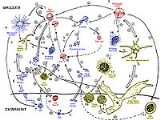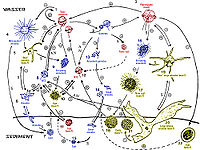
Pfiesteria piscicida
Encyclopedia
Pfiesteria piscicida is a dinoflagellate
species of the genus Pfiesteria
that some researchers claim is responsible for many harmful algal blooms in the 1980s and 1990s on the coast of North Carolina
and Maryland
. The species epithet piscicida means "fish-killer."
 Early research suggested a very complex life cycle
Early research suggested a very complex life cycle
of Pfiesteria piscicida with up to 24 different stages, spanning from cyst
to several amoeboid
forms with toxic zoospore
s. Transformations from one stage to another depend on environmental conditions such as the availability of food. However these results have become controversial as additional research has found only a simple haplontic life cycle with no toxic amoeboid stages and amoeba present on attacked fish may represent an unrelated species of protist
.
into the water to paralyze its prey. This hypothesis has been questioned as no toxin could be isolated and no toxicity was observed in some experiments. However, toxicity appears to depend on the strains and assays used. Polymerase chain reaction
-analyses suggested that the organism lacks the DNA
genes for polyketide
synthesis, the type of toxins associated with most toxic dinoflagellates. Researchers from the NOAA National Centers for Coastal Ocean Science, the National Institute of Standards and Technology
, the Medical University of South Carolina, and the College of Charleston (S.C.) have formally isolated and characterized the toxin in the estuarine dinoflagellete Pfiesteria piscicida as a metal complex and free radical toxin and also have identified how the organism transforms from a non-toxic to toxic state.
(CDC) in Atlanta, U.S.
, at the end of September 1997, attendees agreed on clinical symptoms that characterize the adverse health consequences of exposure to Pfiesteria toxins. These clinical features include:
With these criteria and environmental qualifiers (e.g., 22% of a 50-fish sample, all of the same species, have lesions caused by a toxin), it is likely that Pfiesteria-related surveillance data can better track potential illnesses.
Pfiesteria toxins have been blamed for causing adverse health effects in people who have come in close contact with waters where this organism is abundant. Since June 1997, the Maryland
Department of Health and Hygiene has been collecting data from Maryland physicians through a state-wide surveillance system on illnesses suspected of being caused by Pfiesteria toxin. As of late October 1997, illness was reported by 146 persons who had been exposed to diseased fish or to waters that were the site of suspected Pfiesteria activity. Many of these persons are watermen and commercial fishermen.
The strongest evidence of adverse human health effects so far comes from case studies of two research scientists who were both overcome in their North Carolina
laboratory in 1993. They still complain of adverse effects on their cognitive abilities, particularly after exercising. Duke University Medical Center researchers conducted experiments on rats, which showed that the toxin appeared to slow learning but did not affect memory.
Dinoflagellate
The dinoflagellates are a large group of flagellate protists. Most are marine plankton, but they are common in fresh water habitats as well. Their populations are distributed depending on temperature, salinity, or depth...
species of the genus Pfiesteria
Pfiesteria
Pfiesteria is a genus of heterotrophic dinoflagellates that has been associated with harmful algal blooms and fish kills. Pfiesteria complex organisms were claimed to be responsible for large fish kills in the 1980s and 1990s on the coast of North Carolina and in tributaries of the Chesapeake Bay...
that some researchers claim is responsible for many harmful algal blooms in the 1980s and 1990s on the coast of North Carolina
North Carolina
North Carolina is a state located in the southeastern United States. The state borders South Carolina and Georgia to the south, Tennessee to the west and Virginia to the north. North Carolina contains 100 counties. Its capital is Raleigh, and its largest city is Charlotte...
and Maryland
Maryland
Maryland is a U.S. state located in the Mid Atlantic region of the United States, bordering Virginia, West Virginia, and the District of Columbia to its south and west; Pennsylvania to its north; and Delaware to its east...
. The species epithet piscicida means "fish-killer."
Life Cycles

Biological life cycle
A life cycle is a period involving all different generations of a species succeeding each other through means of reproduction, whether through asexual reproduction or sexual reproduction...
of Pfiesteria piscicida with up to 24 different stages, spanning from cyst
Microbial cyst
A microbial cyst is a resting or dormant stage of a microorganism, usually a bacterium or a protist, that helps the organism to survive in unfavorable environmental conditions. It can be thought of as a state of suspended animation in which the metabolic processes of the cell are slowed down and...
to several amoeboid
Amoeboid
Amoeboids are single-celled life-forms characterized by an irregular shape."Amoeboid" and "amœba" are often used interchangeably even by biologists, and especially refer to a creature moving by using pseudopodia. Most references to "amoebas" or "amoebae" are to amoeboids in general rather than to...
forms with toxic zoospore
Zoospore
A zoospore is a motile asexual spore that uses a flagellum for locomotion. Also called a swarm spore, these spores are created by some algae, bacteria and fungi to propagate themselves.-Flagella:...
s. Transformations from one stage to another depend on environmental conditions such as the availability of food. However these results have become controversial as additional research has found only a simple haplontic life cycle with no toxic amoeboid stages and amoeba present on attacked fish may represent an unrelated species of protist
Protist
Protists are a diverse group of eukaryotic microorganisms. Historically, protists were treated as the kingdom Protista, which includes mostly unicellular organisms that do not fit into the other kingdoms, but this group is contested in modern taxonomy...
.
Toxicity
Pfiesteria presumably kills fish via releasing a toxinToxin
A toxin is a poisonous substance produced within living cells or organisms; man-made substances created by artificial processes are thus excluded...
into the water to paralyze its prey. This hypothesis has been questioned as no toxin could be isolated and no toxicity was observed in some experiments. However, toxicity appears to depend on the strains and assays used. Polymerase chain reaction
Polymerase chain reaction
The polymerase chain reaction is a scientific technique in molecular biology to amplify a single or a few copies of a piece of DNA across several orders of magnitude, generating thousands to millions of copies of a particular DNA sequence....
-analyses suggested that the organism lacks the DNA
DNA
Deoxyribonucleic acid is a nucleic acid that contains the genetic instructions used in the development and functioning of all known living organisms . The DNA segments that carry this genetic information are called genes, but other DNA sequences have structural purposes, or are involved in...
genes for polyketide
Polyketide
Polyketides are secondary metabolites from bacteria, fungi, plants, and animals. Polyketides are usually biosynthesized through the decarboxylative condensation of malonyl-CoA derived extender units in a similar process to fatty acid synthesis...
synthesis, the type of toxins associated with most toxic dinoflagellates. Researchers from the NOAA National Centers for Coastal Ocean Science, the National Institute of Standards and Technology
National Institute of Standards and Technology
The National Institute of Standards and Technology , known between 1901 and 1988 as the National Bureau of Standards , is a measurement standards laboratory, otherwise known as a National Metrological Institute , which is a non-regulatory agency of the United States Department of Commerce...
, the Medical University of South Carolina, and the College of Charleston (S.C.) have formally isolated and characterized the toxin in the estuarine dinoflagellete Pfiesteria piscicida as a metal complex and free radical toxin and also have identified how the organism transforms from a non-toxic to toxic state.
Human Health
Very little research on the human health effects of Pfiesteria toxins has been conducted. At a multi-state workshop at the Centers for Disease Control and PreventionCenters for Disease Control and Prevention
The Centers for Disease Control and Prevention are a United States federal agency under the Department of Health and Human Services headquartered in Druid Hills, unincorporated DeKalb County, Georgia, in Greater Atlanta...
(CDC) in Atlanta, U.S.
United States
The United States of America is a federal constitutional republic comprising fifty states and a federal district...
, at the end of September 1997, attendees agreed on clinical symptoms that characterize the adverse health consequences of exposure to Pfiesteria toxins. These clinical features include:
- memory loss
- confusion
- acute skin burning (on direct contact with water); or
- three or more of an additional set of conditions (headaches, skin rash, eye irritation, upper respiratory irritation, muscle cramps, and gastrointestinal complaints (i.e., nausea, vomiting, diarrhea, and/or abdominal cramps).
With these criteria and environmental qualifiers (e.g., 22% of a 50-fish sample, all of the same species, have lesions caused by a toxin), it is likely that Pfiesteria-related surveillance data can better track potential illnesses.
Pfiesteria toxins have been blamed for causing adverse health effects in people who have come in close contact with waters where this organism is abundant. Since June 1997, the Maryland
Maryland
Maryland is a U.S. state located in the Mid Atlantic region of the United States, bordering Virginia, West Virginia, and the District of Columbia to its south and west; Pennsylvania to its north; and Delaware to its east...
Department of Health and Hygiene has been collecting data from Maryland physicians through a state-wide surveillance system on illnesses suspected of being caused by Pfiesteria toxin. As of late October 1997, illness was reported by 146 persons who had been exposed to diseased fish or to waters that were the site of suspected Pfiesteria activity. Many of these persons are watermen and commercial fishermen.
The strongest evidence of adverse human health effects so far comes from case studies of two research scientists who were both overcome in their North Carolina
North Carolina
North Carolina is a state located in the southeastern United States. The state borders South Carolina and Georgia to the south, Tennessee to the west and Virginia to the north. North Carolina contains 100 counties. Its capital is Raleigh, and its largest city is Charlotte...
laboratory in 1993. They still complain of adverse effects on their cognitive abilities, particularly after exercising. Duke University Medical Center researchers conducted experiments on rats, which showed that the toxin appeared to slow learning but did not affect memory.

